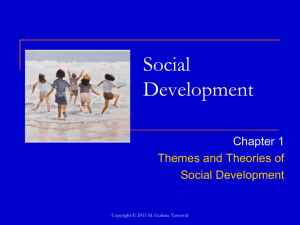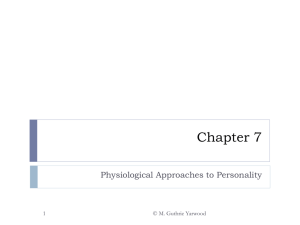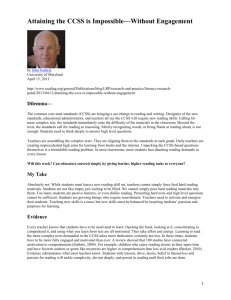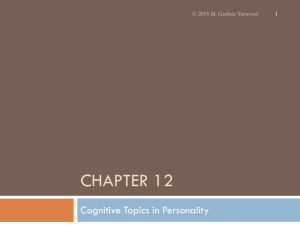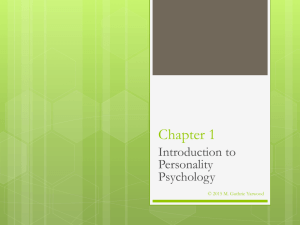Chapter 1 Part 3 (For 9/1 Class)
advertisement
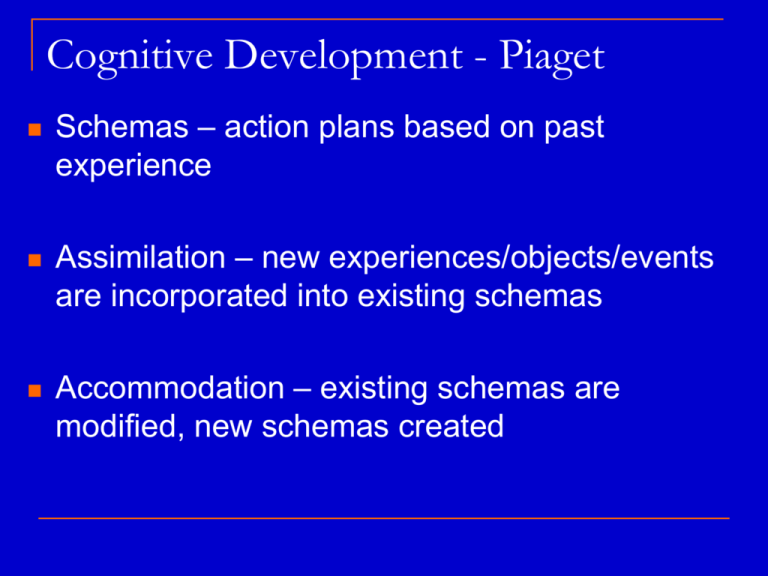
Cognitive Development - Piaget Schemas – action plans based on past experience Assimilation – new experiences/objects/events are incorporated into existing schemas Accommodation – existing schemas are modified, new schemas created Cognitive Development - Piaget Stage Age Characteristics and Achievements Range Sensorimotor 0–2 years Differentiates self from objects and other people, seeks interesting sights, develops object permanence, and basic understanding of causality; begins to imitate and engage in imaginative play Preoperational 2–7 years Begins to use symbols and language; problem solving is intuitive, and thinking is egocentric, irreversible, centered Concrete operations 7–12 years Can reason logically about present objects, grasps concept of conservation, can take the perspective of another person, can organize objects into classes and series Formal operations > 12 years Thinking is flexible and complex; can think about abstract ideas and hypotheses Copyright © 2015 M. Guthrie Yarwood Cognitive Development - Piaget Sensorimotor – Object permanence Preoperational – egocentrism, incapable of conservation, compensation Concrete Operations – conservation, reversibility Formal Operations – hypothetico-deductive thinking, imaginary audience, personal fable Copyright © 2015 M. Guthrie Yarwood Evaluation of Piaget’s Theory Strengths Links between cognition and social reactions Object permanence, Egocentrism Weaknesses Not enough acknowledgement of how children’s interactions with others (vs. objects in the environment) contributes to development Neglect of social, emotional, and cultural influences on development Stage theory criticized Consider Piaget’s Cognitive Development Theory Nature, Nurture, or Both? Active or Passive? Continuous or Discontinuous? Situation, Personality, or Both? Universal, Cultural, or Both? Copyright © 2015 M. Guthrie Yarwood Cognitive Developmental –Vygotsky’s Sociocultural Theory Development emerges from interactions with more skilled people and the institutions and tools provided by the culture Principles of cultural influence Zone of Proximal Development Copyright © 2015 M. Guthrie Yarwood Evaluation of Vygotsky’s Theory Strengths Focused on assessing child potential via the ZPD Offered new perspective on ways to teach children Increased focus on cultural variation and historical influence Weaknesses Not clear how interactions between partners shift over the course of development Not clear how other areas of development contribute to the types of contexts that are made available to children Measurement of ZPD is difficult Copyright © 2015 M. Guthrie Yarwood Consider Vygotsky Nature, Nurture, or Both? Active or Passive? Continuous or Discontinuous? Situation, Personality, or Both? Universal, Cultural, or Both? Copyright © 2015 M. Guthrie Yarwood Systems Theory Perspective Systems approach - describes how children’s development is affected by the interacting components that form one of these systems as well as by single factors within the system Recall Levels of Analyses Dyadic → triadic → long-term → social groups → social networks → society/culture Copyright © 2015 M. Guthrie Yarwood Copyright © 2015 M. Guthrie Yarwood Microsystem - the context in which children live and interact with the people and institutions closest to them Mesosystem - interrelations among the components of the microsystem Exosystem - the collection of settings that influence a child’s development but in which the child does not play a direct role Macrosystem - the system representing the values, ideologies, and laws of the society or culture Chronosystem - the time-based dimension What is the system? Prenatal exposure to alcohol is associated with ADHD in children 13 What is the system? Parents and teachers punish children diagnosed with ADHD, leading these children to develop academic problems and poor peer relationships 14 What is the system? Low-weight children are less likely to develop ADHD when their mother express warmth toward them. What is the system? 70% of children with ADHD who took a stimulant showed improvement in academic performance and peer relationships. What is the system? The prevalence of ADHD is increasing. Some suggest that this rise in ADHD is due to the compulsory schooling requirement set forth by the government. What is the system? Section 504 of the American Disabilities Act was passed in 1973. This act provides reasonable accommodations for students and employees diagnosed with ADHD. Evaluation of Bronfenbrenner’s Theory Strengths Attention to broad range of influential contexts Provides a bridge to other disciplines Weaknesses Useful descriptive guide but does not explain processes Does not explain how different contexts have different influences across development Can be difficult to categorize variables within one system Copyright © 2015 M. Guthrie Yarwood Consider Bronfenbrenner Nature, Nurture, or Both? Active or Passive? Continuous or Discontinuous? Situation, Personality, or Both? Universal, Cultural, or Both? Copyright © 2015 M. Guthrie Yarwood Biological Perspectives Ethological theory - theory that behavior must be viewed in a particular context and as having adaptive or survival value Critical Period vs. Sensitive Period Copyright © 2015 M. Guthrie Yarwood Critical vs. Sensitive Periods Critical Begins/ends abruptly Period beyond which a phenomenon will not appear Lorenz = viewed as completely fixed Sensitive Begins/ends gradually Period of maximal sensitivity Greater flexibility in boundaries of time Evidence for Critical Period Konrad Lorenz goslings Case Studies of children living in deprived environments (e.g., Victor the Wild Child, Genie) The earlier children learn a second (or ALS) language, the better their performance on a language test as adults Somewhere around age 7 or earlier Evidence against a critical period Previously, time b/w birth and age 3 was most important critical period Poor diet before 3 years can be corrected after age 3 If most important period was before age 3, we would solved many problems within developmental psychology! Evaluation of Ethological Theory Strengths Discoveries regarding social development based on animal research Combo of Biology and Environ: Instincts need the right environment to develop properly Weaknesses Largely descriptive Narrowly defined “critical” period with regard to human development Biological Perspectives – Evolutionary Developmental Thy Focus on behaviors that ensured past survival of the species Central principle: parents give their children attention and resources to ensure the passage of their genes through the next generation Copyright © 2015 M. Guthrie Yarwood Evaluation of Evolutionary Developmental Theory Strengths Brings attention to adaptive value of several behaviors observed in childhood Weaknesses Limited relevance for addressing issues associated with rapid changes, such as new technological advances or sudden social shifts Post hoc explanations Copyright © 2015 M. Guthrie Yarwood Biological Perspectives – Human Behavior Genetics Focuses on the relative contributions of heredity and environment to individual differences Strengths Emphasis on environmental causes of behavior Weaknesses Need more specific measure of environment Copyright © 2015 M. Guthrie Yarwood A Variety of Theoretical Perspectives No single theory adequately addresses social development Contemporary theories focus on specified domains Some theories are better at explaining some aspects of social behavior than others All theories are needed to address the broad nature of social development Copyright © 2015 M. Guthrie Yarwood

